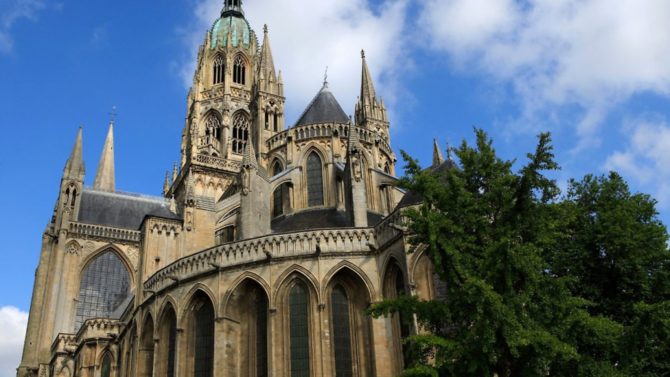Bayeux: A quick tour of the French city, cathedral and tapestry

The breathtaking beauty of Bayeux’s tapestry and cathedral never disappoints, as Rudolf Abraham discovers on a visit to the historic French city in Normandy

The place to begin any tour of Bayeux, Normandy, is with a view of its magnificent cathedral – best appreciated from the corner of Rue Larcher, turning from red to gold in the early morning light.
Consecrated in the presence of William the Conqueror on 14 July 1077, by his half-brother Bishop Odo de Conteville – who is thought to have commissioned the Bayeux Tapestry and likely intended it to be hung in the nave – the Notre-Dame de Bayeux cathedral is a fine example of Norman Romanesque-Gothic architecture.
The west façade has five doors, which make a suitably grand impression although the two outer doors are blind. Inside you’ll find some fantastic diapering (that’s the decorative patterns carved into the stone, nothing to do with nappies) and magnificent, ornately carved wooden pews.

History meets art
Next door to the cathedral is the excellent Musée d’Art et d’Histoire Baron Gérard, based on a group of paintings donated to the city by the conseiller général of Calvados, Baron Henri-Alexandre Gérard, in 1899. It has been continually enlarged since then with donations from the Louvre and Orsay museums, as well as private individuals.
The 5,000 pieces on display include paintings by the likes of Caillebotte and exquisite examples of Bayeux lace. The collection was moved from its old location in the town hall to its new home in the renovated bishop’s palace in 2013, the renovations themselves having unearthed a few surprises such as an unknown Gothic chapel, hidden for hundreds of years.
In a courtyard between the cathedral and the former bishop’s palace, stands a huge Arbre de la Liberté – planted way back on 30 March 1797, and one of the few of the original ‘freedom trees’ planted during the heady days of the French Revolution, to have survived to the present day (many were cut down by Royalists, or have since succumbed to fire, lightning, disease or war).
Memorials and museums
Head down Rue du Bienvenu past beautifully-preserved half-timber houses, to the market on Place Saint-Patrice.

Walk along Rue Royale past the park on Place Charles de Gaulle, to the Museum of the Battle of Normandy, which across a vast exhibition space tells the story of the battle, from the liberation of Bayeux the day after the D-Day landings, to the end of August 1944.
On the other side of the roundabout is the Bayeux War Cemetery, the largest Commonwealth World War II cemetery in France, with 4,150 British and other Commonwealth war graves, together with a memorial bearing the names of a further 1,800 missing.
If you haven’t already loaded yourself up with bottles of cider and Calvados at the market, Lecornu (a local organic orchard and producer) has a little shop on Rue Bourbesneur, where you can sample and buy a few bottles of Normandy’s finest.
Bayeux Tapestry
Across Rue Larcher from the cathedral, the Tapestry Museum (La Tapisserie de Bayeux) is home to one of the most famous textiles in the world – the Bayeux Tapestry, a masterpiece of Romanesque art which illustrates the story of the Norman conquest of England in the 11th century.
The museum is split into three parts – the tapestry itself, an overview of its 11th-century historical context and a film (screened alternately in French and English) which retells its narrative through a series of reconstructions.
The 68m-long tapestry is beautifully exhibited, though it’s due to get an even better, revamped home by 2025, and its scope is mind-boggling – with 58 scenes, featuring 626 characters and 202 horses.
Despite its name, it’s not in fact a tapestry, but embroidery in woollen thread on a linen background. Among the wealth of detail – from the type of armour worn and weapons carried, to architecture and fascinating details of everyday life – look out for Aesop’s fable of The Fox and The Crow among the real and fantastic animals (and in the latter part of the narrative, slaughtered soldiers) decorating the narrow band above and below the main narrative.
After an enjoyable visit to the Tapestry Museum, wander along the Aure river towards busy Rue Saint-Jean, where there are plenty of spots to sit and finish the afternoon with a glass of Calvados.
You might also like
A weekend in Saint-Jean-de-Luz in French Basque Country
Dive into a wellbeing escape on the Atlantic coast in France
Share to: Facebook Twitter LinkedIn Email


